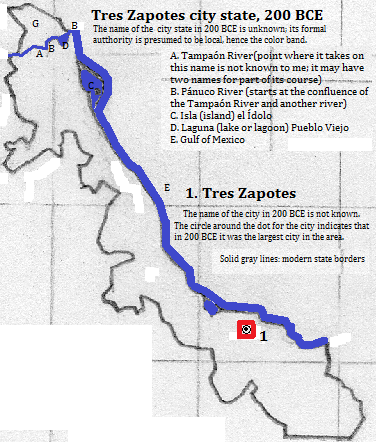Tres Zapotes
Tres Zapotes is an archaeological site named after a near-by village. The ancient name of the city (and what its culture called itself) is unknown as scripts have (as of 2015) not yet been deciphered. The location is in a transitional lowland between the Tuxtlas Mountains and the delta of the Papaloapan River in southern Veracruz State, México. Monuments date from the Meso-American Formative Period, and the settlement flourished after the Olmec Period. The site was abandoned by 900 CE, though later re-occupied.1 Formal authority during the Epi-Olmec and Classical periods was probably local.2
| Year | Population | Political entity |
| 200 BCE | 30,0003| Tres Zapotes city state4 | |
External references
Monumental head from Tres Zapotes, Veracruz State, México
Historical maps




Footnotes
1. https://en.wikipedia.org/wiki/Tres_Zapotes, accessed 7/25/2015. The Epi-Olmec Period begins 400 or 300 BCE.
2. Http://en.wikipedia.org/wiki/Epi-Olmec_culture (accessed 10/13/2014): says "Based on the decentralized placement of mounds groups and monumental sculpture at Tres Zapotes, the Epi-Olmec hierarchy is assumed to have been less centralized than its Olmec predecessor, perhaps featuring a factionalized ruling assembly rather than a single ruler." This cites Christopher Pool Olmec Archaeology and Early Mesoamerica (Cambridge University Press, 2007). Https://en.wikipedia.org/wiki/Classic_Veracruz_culture (accessed 8/10/2015) says "And Elite hereditary rulers held sway over these small- to medium-sized regional centers, none over 2000 kmē," and cites Christopher Poole, 'Gulf Coast Classic,' in Peter N. Peregrine and Melvin Ember, eds., Encyclopedia of Prehistory, Vol. 5, Middle America (Springer Publishing, 2002).
3. Estimate in Tables of the World's Largest Cities, in Tertius Chandler, Four Thousand Years of Urban Growth, 2nd ed. (The Edwin Mellen Press, 1987).
4. The original name of the political entity is unknown.




